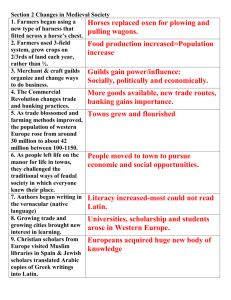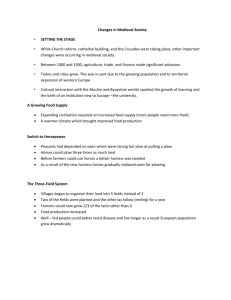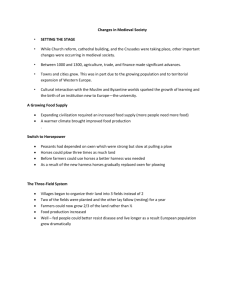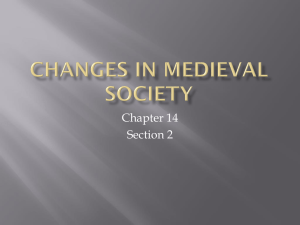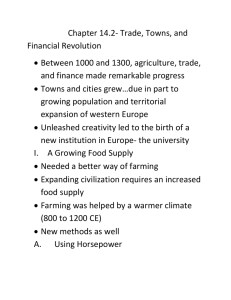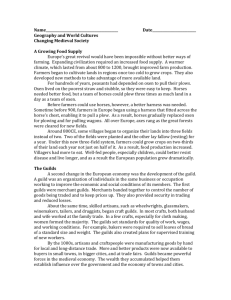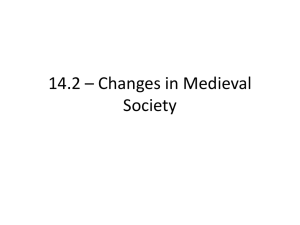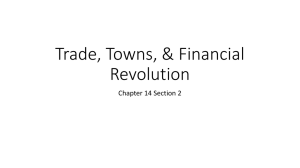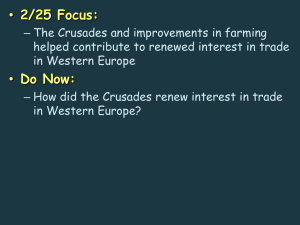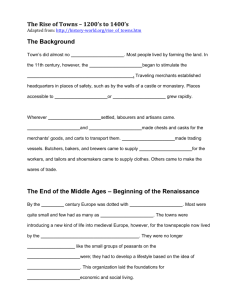2a-Ch_14_Sec_2_Hmk
advertisement
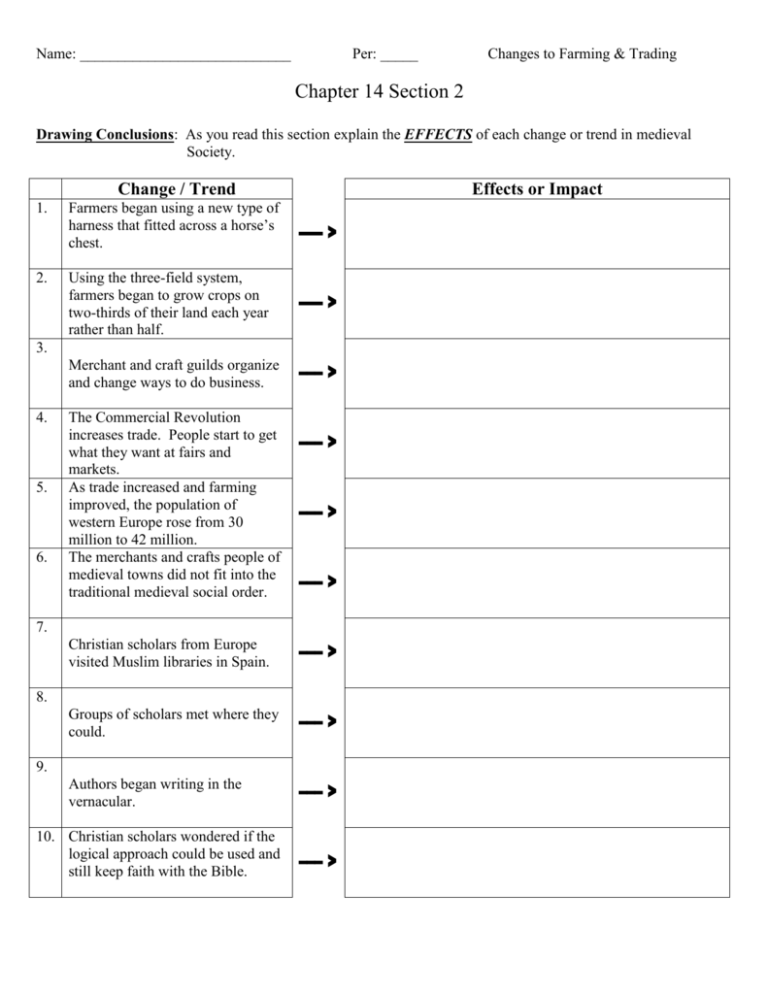
Name: ____________________________ Per: _____ Changes to Farming & Trading Chapter 14 Section 2 Drawing Conclusions: As you read this section explain the EFFECTS of each change or trend in medieval Society. Change / Trend 1. 2. Effects or Impact Farmers began using a new type of harness that fitted across a horse’s chest. --- > Using the three-field system, farmers began to grow crops on two-thirds of their land each year rather than half. --- > Merchant and craft guilds organize and change ways to do business. --- > 3. 4. 5. 6. The Commercial Revolution increases trade. People start to get what they want at fairs and markets. As trade increased and farming improved, the population of western Europe rose from 30 million to 42 million. The merchants and crafts people of medieval towns did not fit into the traditional medieval social order. --- > --- > --- > 7. Christian scholars from Europe visited Muslim libraries in Spain. --- > Groups of scholars met where they could. --- > Authors began writing in the vernacular. --- > 10. Christian scholars wondered if the logical approach could be used and still keep faith with the Bible. --- > 8. 9. Changes in Medieval Society While Church reform, cathedral building, and the Crusades were taking place, other important changes were occurring in medieval society. Between 1000 and 1300, agriculture, trade, and finance made significant advances. Towns and cities grew. This was in part due to the growing population and to territorial expansion of Western Europe. Cultural interaction with the Muslim and Byzantine worlds sparked the growth of learning. A Growing Food Supply Europe’s great revival would have been impossible without better ways of farming. Expanding civilization required an increased food supply. A warmer climate, which lasted from about 800 to 1200, brought improved farm production. Farmers began to cultivate lands in regions once too cold to grow crops. They also developed new methods to take advantage of more available land. Switch to Horsepower For hundreds of years, peasants had depended on oxen to pull their plows. Oxen lived on the poorest straw and stubble, so they were easy to keep. Horses needed better food, but a team of horses could plow three times as much land in a day as a team of oxen. Before farmers could use horses, however, a better harness was needed. Sometime before 900, farmers in Europe began using a harness that fitted across the horse’s chest, enabling it to pull a plow. As a result, horses gradually replaced oxen for plowing and for pulling wagons. All over Europe, axes rang as the great forests were cleared for new fields. The Three-Field System Around A.D. 800, some villages began to organize their lands into three fields instead of two. Two of the fields were planted and the other lay fallow (resting) for a year. Under this new three-field system, farmers could grow crops on two-thirds of their land each year, not just on half of it. As a result, food production increased. Villagers had more to eat. Well-fed people, especially children, could better resist disease and live longer, and as a result the European population grew dramatically. The Guilds A second change in the European economy was the development of the guild. A guild was an organization of individuals in the same business or occupation working to improve the economic and social conditions of its members. The first guilds were merchant guilds. Merchants banded together to control the number of goods being traded and to keep prices up. They also provided security in trading and reduced losses. About the same time, skilled artisans, such as wheelwrights, glassmakers, winemakers, tailors, and druggists, began craft guilds. In most crafts, both husband and wife worked at the family trade. In a few crafts, especially for cloth making, women formed the majority. The guilds set standards for quality of work, wages, and working conditions. For example, bakers were required to sell loaves of bread of a standard size and weight. The guilds also created plans for supervised training of new workers. By the 1000s, artisans and craftspeople were manufacturing goods by hand for local and long-distance trade. More and better products were now available to buyers in small towns, in bigger cities, and at trade fairs. Guilds became powerful forces in the medieval economy. The wealth they accumulated helped them establish influence over the government and the economy of towns and cities. Commercial Revolution Just as agriculture was expanding and craftsmanship changing, so were trade and finance. Increased availability of trade goods and new ways of doing business changed life in Europe. Taken together, this expansion of trade and business is called the Commercial Revolution. Society Changes The changes brought about by the Commercial Revolution were slow, yet they had a major effect on the lives of Europeans. As you can see in the diagram, increased trade brought many changes to aspects of society. Two of the most important changes involved what people did to earn a living and where they lived. As towns attracted workers, the towns grew into cities. Life in the cities was different from life in the sleepy villages or on manors. Urban Life Flourishes Scholars estimate that between 1000 and 1150, the population of western Europe rose from around 30 million to about 42 million. Towns grew and flourished. Compared to great cities like Constantinople, European towns were unsophisticated and tiny. Europe’s largest city, Paris, probably had no more than 60,000 people by the year 1200. A typical town in medieval Europe had only about 1,500 to 2,500 people. Even so, these small communities became a powerful force for change in Europe. Trade and Towns Grow Together By the later Middle Ages, trade was the very lifeblood of the new towns, which sprung up at ports and crossroads, on hilltops, and along rivers. As trade grew, towns all over Europe swelled with people. The excitement and bustle of towns drew many people. But there were some drawbacks to living in a medieval town. Streets were narrow, filled with animals and their waste. With no sewers, most people dumped household and human waste into the street in front of the house. Most people never bathed, and their houses lacked fresh air, light, and clean water. Because houses were built of wood with thatched roofs, they were a constant fire hazard. Nonetheless, many people chose to move to towns to pursue the economic and social opportunities they offered. People were no longer content with their old feudal existence on manors or in tiny villages. Even though legally bound to their lord’s manor, many serfs ran away. According to custom, a serf could now become free by living within a town for a year and a day. A saying of the time went, “Town air makes you free.” Many of these runaway serfs, now free people, made better lives for themselves in towns. Merchant Class Shifts the Social Order The merchants and craftspeople of medieval towns did not fit into the traditional medieval social order of noble, clergy, and peasant. At first, towns came under the authority of feudal lords, who used their authority to levy fees, taxes, and rents. As trade expanded, the burghers, or merchant-class town dwellers, resented this interference in their trade and commerce. They organized themselves and demanded privileges. These included freedom from certain kinds of tolls and the right to govern the town. At times they fought against their landlords and won these rights by force. The Revival of Learning During the Crusades, European contact with Muslims and Byzantines greatly expanded. This contact brought a new interest in learning, especially in the works of Greek philosophers. The Muslim and Byzantine libraries housed copies of these writings. Most had disappeared during the centuries following the fall of Rome and the invasions of Western Europe. The Muslim Connection In the 1100s, Christian scholars from Europe began visiting Muslim libraries in Spain. Few Western scholars knew Greek but most did know Latin. So, Jewish scholars living in Spain translated the Arabic versions of works by Aristotle and other Greek writers into Latin. All at once, Europeans acquired a huge new body of knowledge. This included science, philosophy, law, mathematics, and other fields. In addition, the Crusaders brought back to Europe superior Muslim technology in ships, navigation, and weapons. Scholars and the University At the center of the growth of learning stood a new European institution—the university. The word university originally referred to a group of scholars meeting wherever they could. People, not buildings, made up the medieval university. Universities arose at Paris and at Bologna, Italy, by the end of the 1100s. Others followed at the English town of Oxford and at Salerno, Italy. Most students were the sons of burghers or well-to-do artisans. For most students, the goal was a job in government or the Church. New ideas and forms of expression began to flow out of the universities. At a time when serious scholars and writers were writing in Latin, a few remarkable poets began using a lively vernacular, or the everyday language of their homeland.
